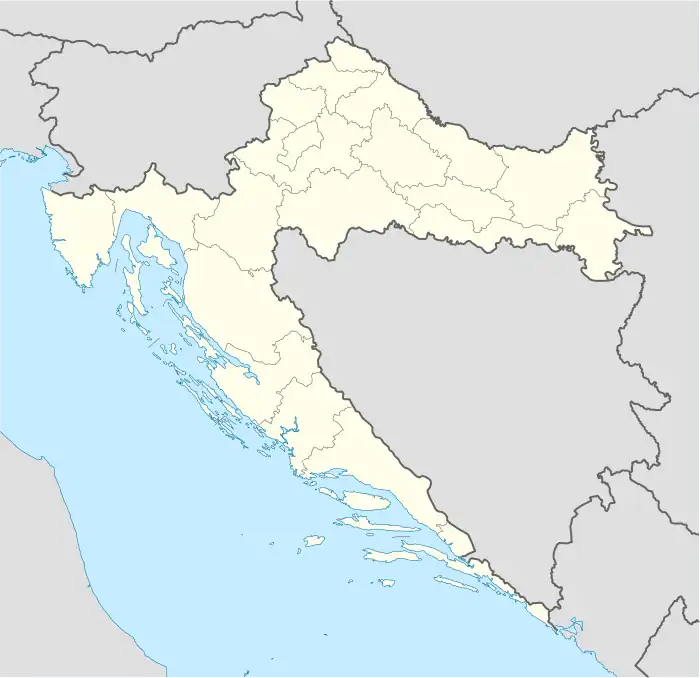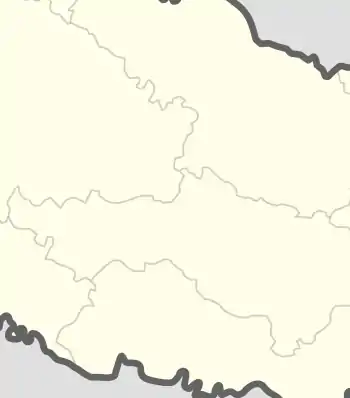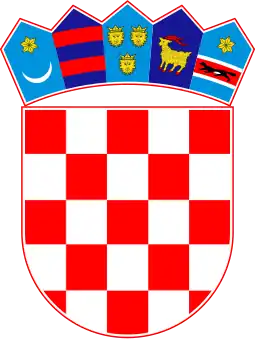| Battle of Kusonje | |||||||
|---|---|---|---|---|---|---|---|
| Part of the Croatian War of Independence | |||||||
 Kusonje Location of Kusonje in Croatia | |||||||
| |||||||
| Belligerents | |||||||
|
|
Support by: | ||||||
| Commanders and leaders | |||||||
|
|
| ||||||
| Units involved | |||||||
|
Company "A" 1st Battalion of the 105th Brigade[1] Omega SPU |
SAO Krajina Infantry Battalion | ||||||
| Casualties and losses | |||||||
| 20 killed (including 7 executed after the battle) | Dozens dead and wounded | ||||||
The Battle of Kusonje was a two-day clash fought in the village of Kusonje near the town of Pakrac on 8–9 September 1991, during the Croatian War of Independence. The battle was initiated when a platoon of the Croatian National Guard (Croatian: Zbor narodne garde – ZNG) was ambushed by Croatian Serb forces while conducting a reconnaissance patrol. The ZNG deployed reinforcements to extract the ambushed platoon, but failed to reach them. The surviving members of the platoon held out until they ran out of ammunition and surrendered only to be killed by their captors and buried in a mass grave.
The fate of the reconnaissance platoon was not known to Croatian authorities for months, adding fuel to an already volatile atmosphere in the city of Bjelovar, where the ambushed unit was originally based. This tension erupted a week later with the blockade and capture of the Yugoslav People's Army (Serbian: Jugoslovenska Narodna Armija – JNA) barracks in Bjelovar.
During a commemoration service held two years later, a landmine exploded killing three and wounding others. The Croatian authorities declared the incident to be a terrorist attack, and it contributed to Croatian government's decision to launch Operation Medak Pocket the next day.
Background
In 1990, ethnic tensions between Serbs and Croats worsened after the electoral defeat of the government of the Socialist Republic of Croatia by the Croatian Democratic Union (Croatian: Hrvatska demokratska zajednica – HDZ). The Yugoslav People's Army (Serbian: Jugoslovenska Narodna Armija – JNA) confiscated Croatia's Territorial Defence (Croatian: Teritorijalna obrana – TO) weapons to minimize resistance.[2] On 17 August, the tensions escalated into an open revolt of the Croatian Serbs,[3] centred on the predominantly Serb-populated areas of the Dalmatian hinterland around Knin (approximately 60 kilometres (37 miles) north-east of Split),[4] parts of the Lika, Kordun, Banovina and eastern Croatia.[5] In January 1991, Serbia, supported by Montenegro and Serbia's provinces of Vojvodina and Kosovo, unsuccessfully tried to obtain the Yugoslav Presidency's approval for a JNA operation to disarm Croatian security forces.[6] The request was denied and a bloodless skirmish between Serb insurgents and Croatian special police in March[7] prompted the JNA itself to ask the Federal Presidency to give it wartime authority and declare a state of emergency. Even though the request was backed by Serbia and its allies, the JNA request was refused on 15 March. Serbian President Slobodan Milošević, preferring a campaign to expand Serbia rather than to preserve Yugoslavia with Croatia as a federal unit, publicly threatened to replace the JNA with a Serbian army and declared that he no longer recognized the authority of the federal Presidency. The threat caused the JNA to abandon plans to preserve Yugoslavia in favour of expansion of Serbia as the JNA came under Milošević's control.[8] By the end of March, the conflict had escalated with the first fatalities.[9] In early April, leaders of the Serb revolt in Croatia declared their intention to amalgamate the areas under their control with Serbia. These were viewed by the Government of Croatia as breakaway regions.[10]
At the beginning of 1991, Croatia had no regular army. To bolster its defence, Croatia doubled its police numbers to about 20,000. The most effective part of the Croatian police force was 3,000-strong special police comprising twelve battalions organised along military lines. There were also 9,000–10,000 regionally organised reserve police in 16 battalions and 10 companies, but they lacked weapons.[11] In response to the deteriorating situation, the Croatian government established the Croatian National Guard (Croatian: Zbor narodne garde – ZNG) in May by expanding the special police battalions into four all-professional guards brigades. Under Ministry of Defence control and commanded by retired JNA General Martin Špegelj, the four guards brigades comprised approximately 8,000 troops.[12] The reserve police, also expanded to 40,000, was attached to the ZNG and reorganised into 19 brigades and 14 independent battalions. The guards brigades were the only units of the ZNG that were fully equipped with small arms; throughout the ZNG there was a lack of heavier weapons and there was poor command and control structure above the brigade level.[11] The shortage of heavy weapons was so severe that the ZNG resorted to using World War II weapons taken from museums and film studios.[13] At the time, the Croatian weapon stockpile consisted of 30,000 small arms purchased abroad and 15,000 previously owned by the police. To replace the personnel lost to the guards brigades, a new 10,000-strong special police was established.[11]
Prelude
Following the first skirmish in Pakrac in March, a predominantly Serb-populated area east of the town, straddling the Pakrac–Bučje–Požega road, remained generally beyond the control of Croatian authorities.[14] In early July, the insurrection spread to the entire area between the towns of Pakrac and Požega and north to the northern slopes of Papuk and Bilogora. This development threatened to interdict the Croatian use of the Varaždin–Osijek road, as it was within range of Croatian Serb artillery near Slatina. After the Serb rebels declared the Serbian Autonomous Oblast of Western Slavonia (SAO Western Slavonia) and expanded the territory under their control to include the town of Okučani, the most significant transport route between Zagreb and Slavonia—the Zagreb–Belgrade motorway between Novska and Nova Gradiška—was severed. SAO Western Slavonia comprised no major settlements. In order to address this deficiency, Croatian Serb forces launched an offensive early on 19 August. The objectives of the offensive were to capture the towns of Grubišno Polje, Daruvar, Pakrac and Lipik, and consolidate the territory of SAO Western Slavonia. The offensive failed after the arrival of Croatian reinforcements from Zagreb and Bjelovar, but the line of control remained in close proximity to the four towns.[15]
Timeline
On 2 September, the ZNG deployed A Company, 1st Battalion, 105th Infantry Brigade to Pakrac in order to reinforce police defences in the area.[16][17] Violence in western Slavonia flared up once more on 3–4 September, when Croatian Serb forces attacked the villages of Četekovac, Čojlug and Balinci south of Slatina, killing two policemen and 21 civilians.[18]
On 8 September, A Company's reconnaissance platoon was tasked with using a gun truck and scouting the area around the village of Kusonje. The platoon encountered no resistance before it reached the village, where it was ambushed by Croatian Serb troops. The platoon's gun truck was disabled and the ZNG troops abandoned it and took shelter in a nearby house.[17]
When it learned of the ambush, the ZNG deployed a force to extract the reconnaissance platoon. The relief force consisted of the rest of A Company, supported by the "Omega" special police unit, reserve police, and ZNG reinforcements from Virovitica.[16] The reinforcements were unable to reach the embattled reconnaissance platoon, which was running low on ammunition. The stalemate continued until the morning of 9 September, when Croatian Serb forces used explosives to demolish a portion of the house in which the reconnaissance platoon had sought cover.[17] Eleven members of the reconnaissance platoon had been killed during the fighting, and the remaining seven had run out of ammunition. They surrendered to the Croatian Serb forces which had surrounded the house, and were then tortured and killed by their captors.[19] The bodies of the victims showed signs of severe torture and mutilation, including evidence of castration and bodies that had their ears, noses and fingers cut off.[20]
Aftermath
As the force which was sent to reinforce and extract the reconnaissance platoon took further casualties,[16] the total Croatian losses in the fighting and its immediate aftermath amounted to 20 killed.[21] The fate of the reconnaissance platoon was not immediately known to Croatian authorities or relatives of the troops for months, adding fuel to an already volatile atmosphere in the city of Bjelovar, where the 105th Brigade was originally based. This tension erupted a week later, with the blockade and capture of the JNA barracks in Bjelovar. The JNA denied it had any knowledge on the fate of the Croatian soldiers.[22] Details of their deaths became known in December 1991.[23] Croatian forces recaptured Kusonje on 30 December in Operation Papuk-91,[24] and their bodies were exhumed in January 1992. Along with the soldiers, the bodies of 23 civilians were also exhumed from a mass grave in the village of Rakov Potok.[25] The soldiers were re-interred in Bjelovar on 5 February 1992. According to JNA intelligence reports, during the period from the exhumation to the re-interment, 32 Serb-owned houses in Bjelovar were demolished in retribution for the killings.[23]
The area was demilitarised following the arrival of the United Nations Protection Force (UNPROFOR) to implement the Vance plan and ceasefire to stabilise the areas affected by the fighting until a political settlement was reached.[26] The area adjacent to the Pakrac–Požega road, especially around Kusonje, remained unsafe. There were numerous attacks along the road, resulting in deaths and injuries.[27] These included an attack on a Croatian police patrol on 5 August 1993, which left four policemen dead and another four wounded.[28] In September 1993, Croatian authorities placed a commemorative plaque at the site of the 1991 ambush and planned a wreath laying ceremony to mark the second anniversary of the event. At 10:20 on 8 September, while the ceremony was in progress, a landmine exploded at the site killing three and injuring eleven.[29] The wounded included one Argentinian member of UNPROFOR.[30] Those killed were members of the ZNG 105th Brigade.[21] The incident, described by the Croatian authorities as an act of terrorism, came on the heels of a series of artillery bombardments and sabotages that resulted in the Croatian government losing its patience with the situation. This contributed to the launching of Operation Medak Pocket the following day.[31]
Croatian authorities prosecuted four people in connection with the 1991 killing of the prisoners of war, and convicted and sentenced them to 15 to 20 years in prison. Another person was tried and convicted in connection with the 1993 bombing, and sentenced to 20 years in prison.[32] In 1998, the Chapel of Nativity of Mary was built in Kusonje at the initiative of the parents of the soldiers who were killed there, and a commemorative plaque containing the names of the 23 killed was placed at the chapel.[33] The events of 1991 and 1993 are commemorated annually in Kusonje, with civilian and military representatives attending.[34] In 2014, a feature film titled Number 55, based on the 1991 events in Kusonje, was released. The title of the film refers to the number of the house where the ZNG troops took shelter on 8–9 September 1991.[19]
Footnotes
- ↑ Marinić, Borna (2020-09-08). "The Battle of Kusonje - They refused to leave their Comrades behind and Died Together". Domovinski rat. Retrieved 2023-09-25.
- ↑ Hoare 2010, p. 117.
- ↑ Hoare 2010, p. 118.
- ↑ The New York Times & 19 August 1990.
- ↑ ICTY & 12 June 2007.
- ↑ Hoare 2010, pp. 118–119.
- ↑ Ramet 2006, pp. 384–385.
- ↑ Hoare 2010, p. 119.
- ↑ Engelberg & 3 March 1991.
- ↑ Sudetic & 2 April 1991.
- 1 2 3 CIA 2002, p. 86.
- ↑ EECIS 1999, pp. 272–278.
- ↑ Ramet 2006, p. 400.
- ↑ Nazor 2007, pp. 131–132.
- ↑ Nazor 2007, p. 132.
- 1 2 3 Bjelovar Info Medij & 10 June 2014.
- 1 2 3 Bjelovar Portal & 6 September 2012.
- ↑ HRW & 21 January 1992.
- 1 2 Kreutz & 5 August 2014.
- ↑ "ICJ: Application of the Convention on the Prevention and Punishment of the crime of Genocide (Croatia v. Serbia), page 229" (PDF). Archived from the original (PDF) on 13 December 2016. Retrieved 19 December 2016.
- 1 2 Index & 8 September 2014.
- ↑ Karaula 2007, p. 17.
- 1 2 Karaula 2007, note 41.
- ↑ Štefančić 2011, p. 429.
- ↑ Hrvatski vojnik 2012.
- ↑ Štefančić 2011, pp. 429–430.
- ↑ Filipović 2008, p. 60.
- ↑ Filipović 2008, p. 65.
- ↑ Međimorec 2004, p. 23.
- ↑ Međimorec 2002, p. 44.
- ↑ Međimorec 2002, p. 45.
- ↑ DORH.
- ↑ HRT & 9 September 1998.
- ↑ MVA & 9 September 2014.
References
- Books
- Central Intelligence Agency, Office of Russian and European Analysis (2002). Balkan Battlegrounds: A Military History of the Yugoslav Conflict, 1990–1995. Washington, D.C.: Central Intelligence Agency. ISBN 9780160664724. OCLC 50396958.
- Eastern Europe and the Commonwealth of Independent States. London, England: Routledge. 1999. ISBN 978-1-85743-058-5.
- Hoare, Marko Attila (2010). "The War of Yugoslav Succession". In Ramet, Sabrina P. (ed.). Central and Southeast European Politics Since 1989. Cambridge, England: Cambridge University Press. pp. 111–136. ISBN 978-1-139-48750-4.
- Nazor, Ante (2007). Počeci suvremene hrvatske države: kronologija procesa osamostaljenja Republike Hrvatske: od Memoranduma SANU 1986. do proglašenja neovisnosti 8. listopada 1991 [Beginnings of the Modern Croatian State: A Chronology of the Independence of the Republic of Croatia: from 1986 SANU Memorandum to the Declaration of Independence on 8 October 1991] (in Croatian). Zagreb, Croatia: Croatian Homeland War Memorial Documentation Centre. ISBN 9789537439019.
- Ramet, Sabrina P. (2006). The Three Yugoslavias: State-Building And Legitimation, 1918–2006. Bloomington, Indiana: Indiana University Press. ISBN 978-0-253-34656-8.
- Journal articles
- Filipović, Vladimir (July 2008). "Kanadska Brigada "Princeza Patricija" u zapadnoj Slavoniji 1992.-1993.: Pripreme, djelovanje, poteškoće" [Canadian Princess Patricia Brigade in Western Slavonia 1992–1993: Preparations, Activities, Problems]. Polemos: Journal of Interdisciplinary Research on War and Peace (in Croatian). Zagreb, Croatia: Croatian Sociological Association and Jesenski & Turk Publishing House. 11 (22): 51–70. ISSN 1331-5595.
- Karaula, Željko (June 2007). "Osvajanje vojarne JNA "Božidar Adžija" u Bjelovaru 1991. godine" [Capture of "Božidar Adžija" JNA barracks in Bjelovar in 1991]. Journal of Contemporary History (in Croatian). Croatian Institute of History. 39 (1): 7–24. ISSN 0590-9597.
- Međimorec, Miroslav (September 2002). "Political and Diplomatic Efforts by the Republic of Croatia and the International Community in Order to Achieve the Peaceful Reintegration of Occupied Areas and Croatia's Full Sovereignty on it's [sic] Complete State Territory". National Security and the Future. Zagreb, Croatia: St. George Association. 3 (3–4): 35–48. ISSN 1332-4454.
- Međimorec, Miroslav (March 2004). "Reakcija UN/MZ – Sporazum o povlačenju UNPROFOR-SITREPORTS" [Reaction of the UN/International Community – UNPROFOR Withdrawal Agreement-SITREPORTS]. National Security and the Future (in Croatian). Zagreb, Croatia: St. George Association. 5 (1–4): 9–34. ISSN 1332-4454.
- Štefančić, Domagoj (December 2011). "Autocesta – okosnica rata u zapadnoj Slavoniji" [Motorway – The Axis of the War in Western Slavonia]. Journal – Institute of Croatian History (in Croatian). Institute of Croatian History, Faculty of Philosophy, Zagreb, FF press. 43 (1): 427–455. ISSN 0353-295X.
- News reports
- "21. godišnjica tragične pogibije hrvatskih branitelja u Kusonjama" [21st Anniversary of Tragic Death of Croatian Defenders in Kusonje] (in Croatian). Bjelovar Portal. 6 September 2012. Archived from the original on 4 March 2016. Retrieved 19 November 2014.
- Engelberg, Stephen (3 March 1991). "Belgrade Sends Troops to Croatia Town". The New York Times. Archived from the original on 2 October 2013.
- "Kratke vijesti" [News in Brief] (in Croatian). Croatian Radiotelevision. 9 September 1998. Archived from the original on 5 March 2016. Retrieved 19 November 2014.
- Kreutz, Andrej (5 August 2014). "Otkrivamo tko su bili hrvatski heroji o kojima je snimljen film" [We Discover Croatian Heroes About whom the Film was Made]. 24sata (Croatia) (in Croatian).
- "Obilježena 23. obljetnica A satnije Zbora narodne garde, prve vojne postrojbe u BBŽ" [23rd Anniversary of A-company of the Croatian National Guard, the First Armed Unit in the Bjelovar-Bilogora County] (in Croatian). Bjelovar Info Medij. 10 June 2014. Archived from the original on 7 March 2016. Retrieved 19 November 2014.
- "Roads Sealed as Yugoslav Unrest Mounts". The New York Times. Reuters. 19 August 1990. Archived from the original on 21 September 2013.
- Sudetic, Chuck (2 April 1991). "Rebel Serbs Complicate Rift on Yugoslav Unity". The New York Times. Archived from the original on 2 October 2013.
- "U Kusonjama održana komemoracija za 23 poginula branitelja iz Bjelovara" [Commemoration for 23 Killed Defenders from Bjelovar Held in Kusonje] (in Croatian). Index.hr. HINA. 8 September 2014.
- Other sources
- "Letter to His Excellency Slobodan Milošević and General Blagoje Adžić" (PDF). Human Rights Watch. 21 January 1992.
- "Obilježena 23. godišnjica pogibije hrvatskih branitelja u Kusonjama" [23rd Anniversary of Death of Croatian Defender in Kusonje Marked] (in Croatian). Ministry of Veterans' Affairs (Croatia). 9 September 2014. Archived from the original on 2014-09-13.
- "Odgovor na upite vezano za zločin u Kusonjama" [Reply to Inquiries about the Crime in Kusonje] (in Croatian). State Attorney's Office of the Republic of Croatia.
- "Sjećanje na tragičnu pogibiju hrvatskih vojnika u Kusonjama" [Remembrance of Tragic Death of Croatian Soldiers in Kusonje]. Hrvatski vojnik (in Croatian). Ministry of Defence (Croatia). September 2012. ISSN 1333-9036. Archived from the original on 2014-11-19. Retrieved 2014-11-19.
- "The Prosecutor vs. Milan Martic – Judgement" (PDF). International Criminal Tribunal for the former Yugoslavia. 12 June 2007.

.svg.png.webp)
_(1868-1918).svg.png.webp)
